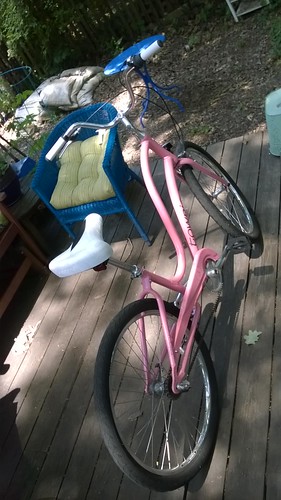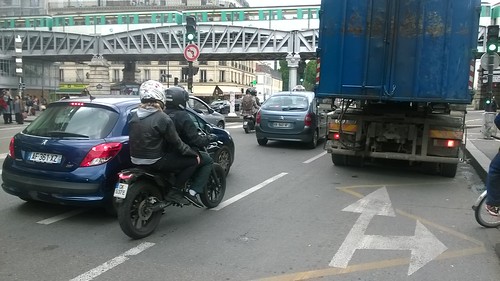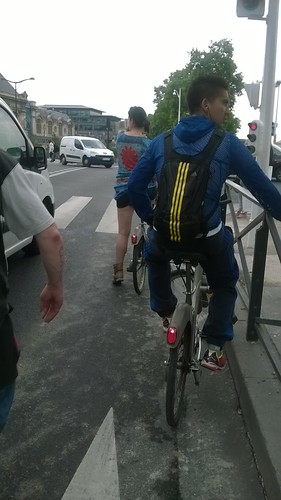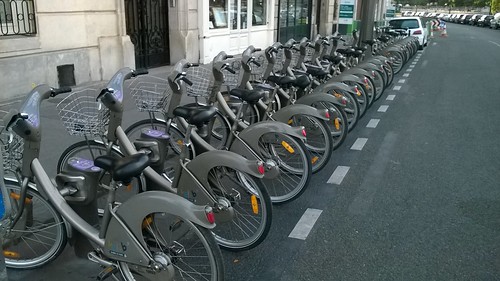When the first diamond frame bicycles became popular in the 1890s they were often called "wheels" - the national cycling association was called the "League of American Wheelmen." We have moved from "wheels" to "bikes," but the bicycles have remained remarkably the same over more than 100 years - elegant in their efficiency and simplicity. And many of the issues that we think are new? They were around then too.
Wednesday, July 2, 2014
Four Mile Run Detour Re-Opens
This past Monday the detour for the Four Mile Run trail near the south end of National Airport was removed. The section of the trail that was under the bridge that was removed (see above) was widened somewhat and is edged on the inner side with some raised concrete. Work was being completed yesterday but the fences that enforced the detour were completely removed, so I am fairly sure it is OK to say the detour is done. It was open again this morning on the way to work.
The photo above shows the trail east of where the detour started - you can see that the bushes have taken over some of the trail while the work has been going on. Presumably Alexandria (I think this part of the trail is theirs) will send someone along to trim things up.
I was stopped to take this photo and blocking about 1/3 of the trail. The fellow in the photo came upon me and said, "excuse me" in a cranky tone which I took to be his way of complaining that I was blocking his speedy transit of this area. I don't know why people don't communicate more directly. What he clearly meant was, "you are in my f---ing way." Oh well. Mostly other cyclists seemed extremely pleased that the detour was over. I agree.
Saturday, June 28, 2014
31.5 Pounds of Fun

Pink Electra Townie - 31.5 pounds
This bike belongs to my wife but I ride it to and from a shopping area that is about a mile away on the weekends sometimes. The three-speed hub shift reminds me of riding a bike-share bike except it has a coaster brake, which takes some getting used to - it also has a rim brake for the front wheel, which does most of the real work of stopping.
The odd geometry that makes it possible to put one's foot on the ground easily while sitting on the seat works for me OK but I sort of feel like I'm hanging on the handlebars somehow.
I guess some components are heavy - given that the frame is aluminum tubing, 31.5 pounds seems a lot. But then the kickstand probably ways several pounds . . .
Sunday, June 22, 2014
How Bicycles Are Built (in 1896)
How Bicycles are Built. (article)
Author: Monroe Sonneschein
Publisher: [Chicago : : R. Sonneschein], June 1896.
Journal title: American Jewess : Vol 2 : Issue 9.; Page(s) 457-465.
This article provides a surprising type and amount of information compared to others I have seen from this period, particularly since it was intended as a tutorial for women readers assumed to know little about bicycles who would use this information to inform purchase of a bicycle. (While I think it is a interesting article, I'm not so sure that much of what is covered would be useful for a successful bicycle purchase, however.) I think it is worth looking at the entire article - here are some highlights:
Image from the book "A Wheel Within a Wheel: How I Learned to Ride the Ricycle. . . " by Frances E. Willard, 1895. This book is available here - hdl.handle.net/2027/wu.89098879422
More from "How Bicycles Are Built:"
Author: Monroe Sonneschein
Publisher: [Chicago : : R. Sonneschein], June 1896.
Journal title: American Jewess : Vol 2 : Issue 9.; Page(s) 457-465.
This article provides a surprising type and amount of information compared to others I have seen from this period, particularly since it was intended as a tutorial for women readers assumed to know little about bicycles who would use this information to inform purchase of a bicycle. (While I think it is a interesting article, I'm not so sure that much of what is covered would be useful for a successful bicycle purchase, however.) I think it is worth looking at the entire article - here are some highlights:
HOW BICYCLES ARE BUILT. This article is written with a view of enlightening the purchaser of a wheel, who, as a rule, knows nothing about the construction and mechanical advantages of one bicycle over another.Guns are designed to be safer than bicycles?? Apparently.
Scientific men who have made bicycle-building their study all agree that the construction of a modern safety is one of the most delicate and intricate problems in mechanics, easily taking rank with locomotive or bridge-building. In most high-grade wheels there are about one hundred separate and distinct parts. Including duplicates, there are some seven hundred and fifty pieces in all. The puzzles and conundrums propounded by the wise men would seem easy of solution in comparison with the task of assembling the parts of a bicycle into one compact, rigid and smoothly-running machine. It is an undertaking requiring the highest degree of mechanical intelligence.
In a gun,"the factor of safety," as it is termed by engineers, is never lower than 12, which means that it is designed to be 12 times stronger than the strain it is calculated to withstand. In general machinery, the "factor of safety" is from 4 to 5; but in a bicycle it is but 1 1/4, in order that the machine may be as light as possible. It can therefore be readily understood that the greatest care must be exercised in its manufacture.
Image from the book "A Wheel Within a Wheel: How I Learned to Ride the Ricycle. . . " by Frances E. Willard, 1895. This book is available here - hdl.handle.net/2027/wu.89098879422
More from "How Bicycles Are Built:"
A bicycle frame must be designed to withstand all manner of strains, such as longitudinal, tortional and vibrational, and their many combinations. It must stand up well in collision and the shock consequent to a fall at high speed. And right here let me state that too much rigidity in a frame is almost as faulty as not enough of it.Wheels with rims made from wood were still common at this point.
The bearings of a bicycle are perhaps its most interesting feature. The wear upon these parts is almost constant, and the material used should be of the finest steel tempered in oil all the way through, and not only case-hardened, because casehardening is merely hardening the outside of the metal. When such a temper is used, the hardened surface soon wears through; and the balls, reaching the softer metal of the inside, in a very short time eat away the bearing.
After the frame, the putting together of a bicycle wheel is the most important step in cycle-building. Each spoke is tested to support a hanging weight of not less than 1,000 pounds. The hub-the foundation of the wheel-is turned from a solid bar of steel. A hole for the axle is bored lengthwise through its center, as well as many smaller holes in the flanges around the outside of its ends, to hold the spokes.
In the wooden rim there is, of course, a hole for each spoke. These holes are "countersunk," and "washers" are introduced to prevent the spokes from pulling through the rims; for it is an interesting fact that, while the weight in a wooden wheel stands on the spokes, in a bicycle wheel it hangs on the spokes, the spokes above the hub supporting most of the weight. Were it otherwise, the wheel would quickly collapse; for while the tiny wires are capable of bearing an enormous lengthwise strain, they would immediately bend under a trifling compressional one.
There is no device known to mechanics which minimizes friction to so great an extent as the ball-bearing. Running parts equipped with it may truly be said to possess the poetry of motion; yet how few among the thousands of wheelmen understand its magical workings!The complete articlehas additional details about bicycle manufacturing practices of the 1890s.
Sunday, June 8, 2014
A Norwegian Approach to Routinizing Climbing of Steep Hills
They could use something like this in Seattle
Pretty flat around Washington DC, but I can easily imagine having something like this in various places I have been.
It does not seem, however, to have caught on even in Norway where they developed it, so probably not very likely to been seen in this country any time soon.
Saturday, May 31, 2014
Commuting - Racing or Relaxing?
From user Landahlauts via Creative Commons in Flickr
In Paris for a week, I commuted about 3-4 kilometers back and forth to the National Library every day from the hotel to attend a conference. I would wear the clothes I would be in all day and didn't take a helmet to Paris, so no helmet. I mostly rode at a much more leisurely pace than I do at home but then the bikeshare bikes don't support much in the way of speed (or braking either, so perhaps that's good).
In my Arlington-Washington commute, I spend most of the time on trails and wear bicycling garb (ie, lyrca etc.) and try to maintain a high rate of speed - I work up a sweat. I shower and change at work. But then the distance is more like 17 kilometers one way. And I wear a helmet.
Parke Davis employees of 1899 leaving work, many on bicycles
Before cars become popular and extremely inexpensive, bicycles were briefly used by some for commuting much like Parisians do now, or so evidence like this short film clip seem to suggest.
I have given some thought about the similarity and differences between the commuting I did in Paris, which is less of a production (in the sense of not wearing special clothes, helmets, etc.) and what I do at home. I have concluded that the similarities (it is still biking) are more important than the differences. I regard Capital Bikeshare riders here as fellow travelers, so to speak, in a real sense.
Something unusual - an abandoned (unlocked) Capital Bikeshare bike
One thing I really enjoy about bikeshare biking, which I have done in Paris several times and in Boston, is that I immediately lose any concern with my rate of travel - unlike when I am on a road bike and I sometimes have to fight a desire to go fast (or as fast as I can, anyway). A typical bikeshare bike immediately says to me as I sit on it something about the improbability of going fast (I guess) so I don't think of the experience in terms of speed, but simply of pleasing forward motion. Since my misguided competitive urge that appears while sitting on a road bike disappears, the experience seems better than riding a road bike! (But I may be reading too much into this since I have done most of my bikeshare biking in Paris, and being in Paris may have something to do with this.)
Thursday, May 22, 2014
Saturday, May 10, 2014
Bike Share Pricing, Paris vs US
Me some years back with a Velibe bicycle in Paris
I am fortunate enough to have a trip planned to Paris in a week. I will be at some meetings at the national library for most of the week. Very nice. The hotel I will be at is about 3 km from the national library, along the Seine river. It is very easy to navigate back and forth using a bikeshare bike from Velibe.
I have already purchased my seven day subscription for Velibe when I will be in Paris. The cost is only 8 Euros for a week. By comparison, CitiBike in NYC is 9.95 (plus tax!) for one day and $25 (again, plus tax!) for a seven day "access pass." Capital Bikeshare here in the DC area is at once more and less - $7 for 24 hours but there is no seven day option, rather one can pay $15 for three days - uck. (Taxes are apparently included for Capital Bikeshare.)
The American view of pricing bikeshare is that the operational costs are supposed to more or less be covered by the user fees - but typically the short term rental folks are subsidizing those with annual subscriptions so it is all relative. In Paris they must be taking the view that bikeshare is more like public transit, where typically "the farebox" (revenue direct from users) is only a portion of the support. This so-called farebox recovery rate can be all over the place - in Austin Texas, it seems to be less than ten percent! - while in Chicago it is more than 50 percent. But for now Americans want bikeshare to pay for itself - 100 percent.
Hmm. Ironically my use of Velibe in Paris will be covered by the American taxpayer who will be funding this incidental expense of my trip, so the French taxpayer is, in this very very minor way, subsiding the US of A.
Subscribe to:
Posts (Atom)



